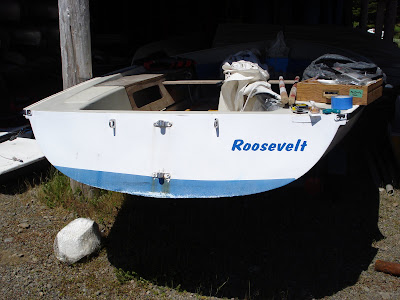Just for kicks, my uncle and I decided to sign up for
classes at a rowing club on Lake Union.
We’ve been doing it now for almost three weeks. At this point in life, I consider
myself a fairly old hand at rowing, since we did it every single day on the
Camp Parsons waterfront in the 14-foot aluminum Smokercrafts. As you can imagine, though, rowing an eight-man racing shell is really a very different sort of game. No longer am I slogging around in a heavy, metal
bathtub. Suddenly I’m in a seat
that slides, I’m inches above the water, I’m sweeping on one side only, I have
to keep tempo with seven other people, and I’m going a whole hell of a lot
faster.
I never before realized how much of a science there was to
rowing. There is a whole technique
designed to maximize the use of your strongest muscle groups (the legs) and
minimize the use of your weaker muscle groups (the arms and back), while at the
same time minimizing air resistance on the blades, minimizing the braking
effect that comes from sliding your body forward, and maximizing the efficiency
of the blade’s contact with the water.
For each iteration of a stroke, I’d say that there are about two dozen individual
things that you have to remind your body to do, and you have to do them all in
the right sequence every time.
I love that sort of thing. There’s something remarkably therapeutic and anesthetic about
it all. It forces you to stop
thinking about all the crap that goes on in the world and focus instead on the
timing of your breaths, the depth of your blade, the squareness of your
shoulders, the rotations of your wrist, the straightness of your back, the balance of the boat, and all the while you're trying to swing your body in perfect rhythm with the body in front of
you, as if all eight of you were tied together with a string. After a while, it becomes almost a form of self-hypnotism, and you reach a very different level of consciousness.
But it wasn't that way at first. On the way to the first day of class, I was hoping that the
other guys in the class would turn out to be rickety, pot-bellied, middle-aged
men, and that way I didn’t have to feel insecure about my own deplorable lack
of physique. To my dismay,
however, my classmates turned out to be your regular statuesque, gym-going
types. Yes, there they were in
their tight workout clothes, and then here was scrawny, gangling, pathetic me. Damn.
Yesterday, though, we were out on Lake Union, and there was
a guy who hadn’t been to class in a while, so the instructor had him sit out
and ride in the escort boat with him in order to watch us. Now by the end of that class, I was getting a little vexed with the instructor, because he was giving a lot of feedback to every other guy, but he
didn’t say a single damned thing to me, neither positive nor negative. Sometimes that means that the
instructor has given up on you as a lost cause. After class, I talked with the guy who had to sit out and ride
with the instructor. It turns out
that the reason the instructor never said anything to me was that whenever it was
my turn to row, he turned around to talk to the guy and was using me as an example to explain how to row correctly.
I have never been good at a sport before. During Aquatics Instructor training
last summer, Gary told me that I have a kind of gift for picturing what my body
is supposed to do, and then doing it.
I didn’t really believe that then.
At the risk of sounding vain, I’m starting to think it might be
true. I’ve kind of already
committed this lifetime to sailing, and I’m a little too over-the-hill to
switch passions now, but I think in my next life, I’m going to be a rower.















